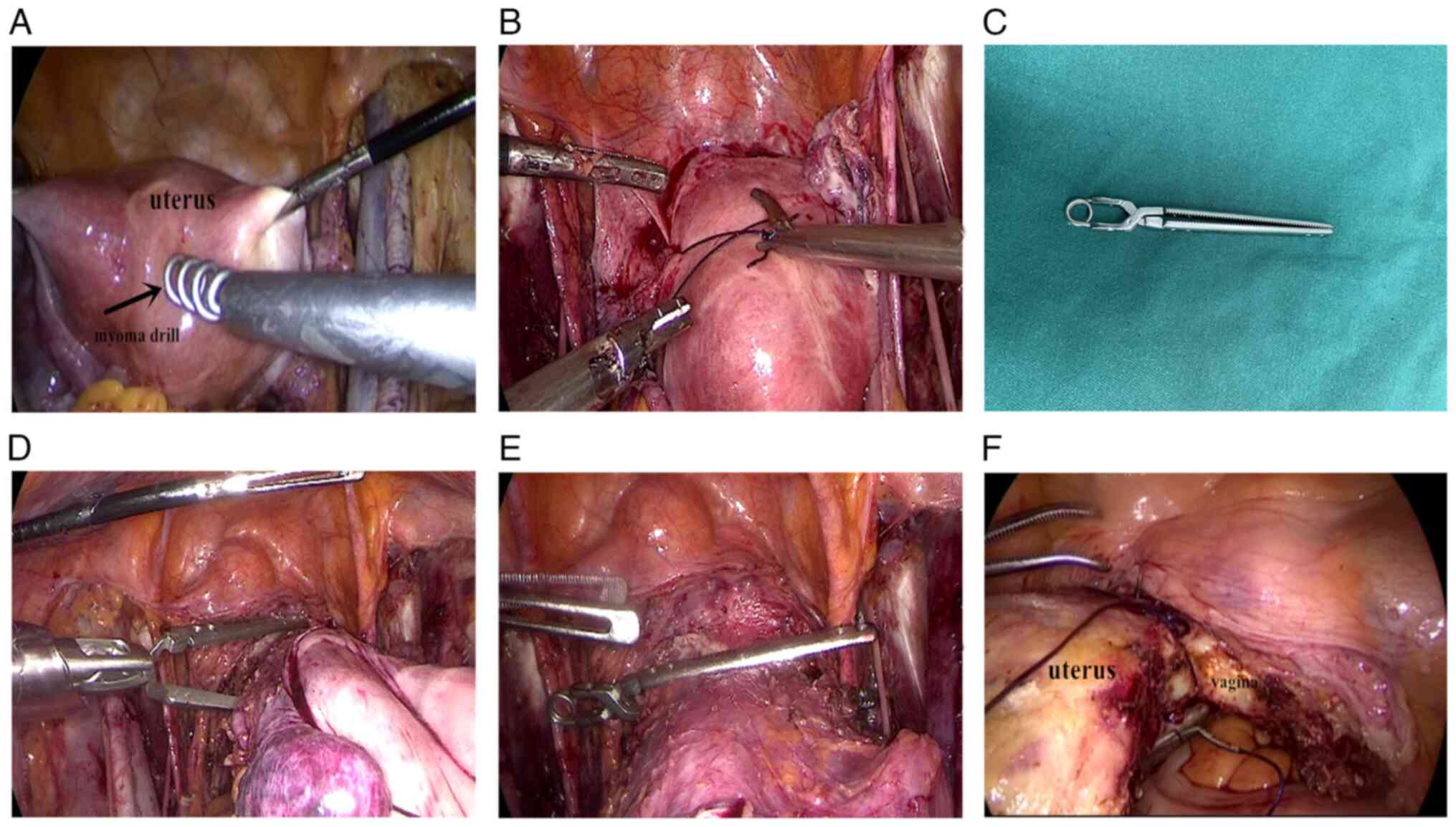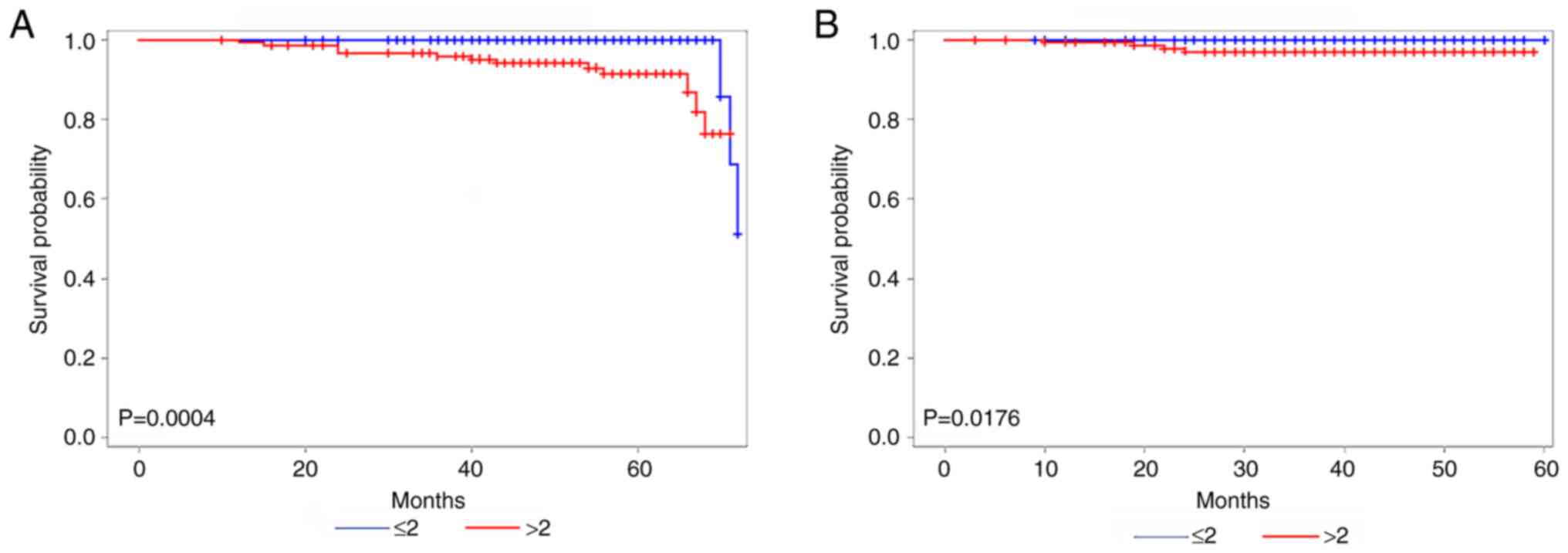|
1
|
Siegel RL, Miller KD and Jemal A: Cancer
statistics, 2020. CA Cancer J Clin. 70:7–30. 2020. View Article : Google Scholar : PubMed/NCBI
|
|
2
|
Casarin J, Buda A, Bogani G, Fanfani F,
Papadia A, Ceccaroni M, Malzoni M, Pellegrino A, Ferrari F, Greggi
S, et al: Predictors of recurrence following laparoscopic radical
hysterectomy for early-stage cervical cancer: A multi-institutional
study. Gynecol Oncol. 159:164–170. 2020. View Article : Google Scholar : PubMed/NCBI
|
|
3
|
Philp L, Covens A, Vicus D, Kupets R,
Pulman K and Gien LT: Feasibility and safety of same-day discharge
after laparoscopic radical hysterectomy for cervix cancer. Gynecol
Oncol. 147:572–576. 2017. View Article : Google Scholar : PubMed/NCBI
|
|
4
|
Jensen PT, Schnack TH, Frøding LP, Bjørn
SF, Lajer H, Markauskas A, Jochumsen KM, Fuglsang K, Dinesen J,
Søgaard CH, et al: Survival after a nationwide adoption of robotic
minimally invasive surgery for early-stage cervical cancer-a
population-based study. Eur J Cancer. 128:47–56. 2020. View Article : Google Scholar : PubMed/NCBI
|
|
5
|
Ramirez PT, Frumovitz M, Pareja R, Lopez
A, Vieira M, Ribeiro R, Buda A, Yan X, Shuzhong Y, Chetty N, et al:
Minimally invasive versus abdominal radical hysterectomy for
cervical cancer. N Engl J Med. 379:1895–1904. 2018. View Article : Google Scholar : PubMed/NCBI
|
|
6
|
Charo LM, Vaida F, Eskander RN, Binder P,
Saenz C, McHale M and Plaxe S: Rapid dissemination of
practice-changing information: A longitudinal analysis of
real-world rates of minimally invasive radical hysterectomy before
and after presentation of the LACC trial. Gynecol Oncol.
157:494–499. 2020. View Article : Google Scholar : PubMed/NCBI
|
|
7
|
Hillemanns P, Brucker S, Holthaus B, Lampe
B, Runnebaum I, Ulrich U, Wallwiener M, Solomayer E, Fehm T and
Tempfer C: Comment on the LACC trial investigating early-stage
cervical cancer by the uterus commission of the study group for
gynecologic oncology (AGO) and the study group for gynecologic
endoscopy (AGE) of the German society for gynecology and obstetics
(DGGG). Geburtshilfe Frauenheilkd. 78:766–767. 2018. View Article : Google Scholar : PubMed/NCBI
|
|
8
|
Park JY and Nam JH: How should gynecologic
oncologists react to the unexpected results of LACC trial? J
Gynecol Oncol. 29:e742018. View Article : Google Scholar : PubMed/NCBI
|
|
9
|
National Comprehensive Cancer Network, .
NCCN Clinical Practice Guidelines in Oncology - Cervical Cancer,
Version 4. 2019.https://www2.tri-kobe.org/nccn/guideline/gynecological/english/cervical.pdfDecember
30–2021
|
|
10
|
Cibula D, Pötter R, Planchamp F,
Avall-Lundqvist E, Fischerova D, Haie Meder C, Köhler C, Landoni F,
Lax S, Lindegaard JC, et al: The European society of gynaecological
oncology/European society for radiotherapy and oncology/European
society of pathology guidelines for the management of patients with
cervical cancer. Int J Gynecol Cancer. 28:641–655. 2018. View Article : Google Scholar : PubMed/NCBI
|
|
11
|
Wang YZ, Deng L, Xu HC, Zhang Y and Liang
ZQ: Laparoscopy versus laparotomy for the management of early stage
cervical cancer. BMC Cancer. 15:9282015. View Article : Google Scholar : PubMed/NCBI
|
|
12
|
Nam JH, Park JY, Kim DY, Kim JH, Kim YM
and Kim YT: Laparoscopic versus open radical hysterectomy in
early-stage cervical cancer: Long-term survival outcomes in a
matched cohort study. Ann Oncol. 23:903–911. 2012. View Article : Google Scholar : PubMed/NCBI
|
|
13
|
Chen Y, Xu H, Li Y, Wang D, Li J, Yuan J
and Liang Z: The outcome of laparoscopic radical hysterectomy and
lymphadenectomy for cervical cancer: A prospective analysis of 295
patients. Ann Surg Oncol. 15:2847–2855. 2008. View Article : Google Scholar : PubMed/NCBI
|
|
14
|
Gallotta V, Conte C, Federico A, Vizzielli
G, Gueli Alletti S, Tortorella L, Pedone Anchora L, Cosentino F,
Chiantera V, Fagotti A, et al: Robotic versus laparoscopic radical
hysterectomy in early cervical cancer: A case matched control
study. Eur J Surg Oncol. 44:754–759. 2018. View Article : Google Scholar : PubMed/NCBI
|
|
15
|
Sert BM, Boggess JF, Ahmad S, Jackson AL,
Stavitzski NM, Dahl AA and Holloway RW: Robot-assisted versus open
radical hysterectomy: A multi-institutional experience for
early-stage cervical cancer. Eur J Surg Oncol. 42:513–522. 2016.
View Article : Google Scholar : PubMed/NCBI
|
|
16
|
Köhler C, Hertel H, Herrmann J, Marnitz S,
Mallmann P, Favero G, Plaikner A, Martus P, Gajda M and Schneider
A: Laparoscopic radical hysterectomy with transvaginal closure of
vaginal cuff-a multicenter analysis. Int J Gynecol Cancer.
29:845–850. 2019. View Article : Google Scholar : PubMed/NCBI
|
|
17
|
Shah CA, Beck T, Liao JB, Giannakopoulos
NV, Veljovich D and Paley P: Surgical and oncologic outcomes after
robotic radical hysterectomy as compared to open radical
hysterectomy in the treatment of early cervical cancer. J Gynecol
Oncol. 28:e822017. View Article : Google Scholar : PubMed/NCBI
|
|
18
|
Melamed A, Margul DJ, Chen L, Keating NL,
Del Carmen MG, Yang J, Seagle BL, Alexander A, Barber EL, Rice LW,
et al: Survival after minimally invasive radical hysterectomy for
early-stage cervical cancer. New Engl J Med. 379:1905–1914. 2018.
View Article : Google Scholar : PubMed/NCBI
|
|
19
|
Kim SI, Cho JH, Seol A, Kim YI, Lee M, Kim
HS, Chung HH, Kim JW, Park NH and Song YS: Comparison of survival
outcomes between minimally invasive surgery and conventional open
surgery for radical hysterectomy as primary treatment in patients
with stage iB1-IIA2 cervical cancer. Gynecol Oncol. 153:3–12. 2019.
View Article : Google Scholar : PubMed/NCBI
|
|
20
|
Doo DW, Kirkland CT, Griswold LH, McGwin
G, Huh WK, Leath CA III and Kim KH: Comparative outcomes between
robotic and abdominal radical hysterectomy for IB1 cervical cancer:
Results from a single high volume institution. Gynecol Oncol.
153:242–247. 2019. View Article : Google Scholar : PubMed/NCBI
|
|
21
|
Alfonzo E, Wallin E, Ekdahl L, Staf C,
Rådestad AF, Reynisson P, Stålberg K, Falconer H, Persson J and
Dahm-Kähler P: No survival difference between robotic and open
radical hysterectomy for women with early-stage cervical cancer:
Results from a nationwide population based cohort study. Eur J
Cancer. 116:169–177. 2019. View Article : Google Scholar : PubMed/NCBI
|
|
22
|
Wenzel HHB, Smolders RGV, Beltman JJ,
Lambrechts S, Trum HW, Yigit R, Zusterzeel PLM, Zweemer RP, Mom CH,
Bekkers RLM, et al: Survival of patients with early-stage cervical
cancer after abdominal or laparoscopic radical hysterectomy: A
nationwide cohort study and literature review. Eur J Cancer.
133:14–21. 2020. View Article : Google Scholar : PubMed/NCBI
|












